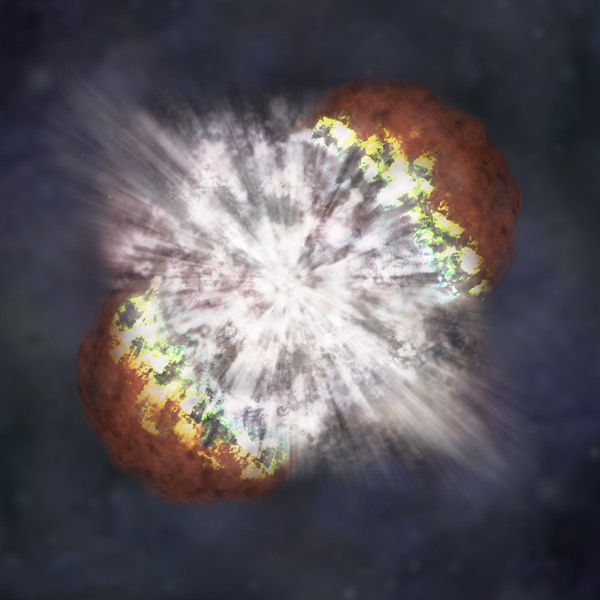
Quark Stars
In our last thrilling episode you will remember that we talked about SN2006gy; the biggest super nova ever found. Well, Robert Quimby, who found SN2006gy, had already found another super nova that was twice as bright. He just didn't know he had found it. A year earlier, he recorded SN2005ap but, since it was so far away (4.7 Billion light years) and decayed in brightness way faster than SN2006gy, it wasn't until 2008 that the data was examined and he found SN2005ap to be brighter.
You remember that SN2006gy was a "new" kind of supernova with two energetic atmospheric shells colliding. SN2005ap wasn't the same kind of supernova. It was way brighter and decayed in brightness way faster. It was a tough one to explain.
Here's the best guess so far: Did you ever see the TV show Deep Space Nine? No? You're too young I guess. Anyway, there was a tavern on the space station owned and run by a Ferengi by the name of Quark. I liked him. Maybe SN2005ap was the formation of a Quark Star. (No, no, no! You don't make one by smashing Ferengi together!)
Remember in your science class when your teacher taught you that atoms are made of electrons orbiting about a nucleus of neutrons and protons? Our best guess is that electrons are "elementary" and can't be taken apart into anything simpler. Hadrons - neutrons and protons - seem to be made from more elementary particles called quarks. Quarks come in six varieties known as "colors"; *up, down, charm, strange, top,* and *bottom* (no, they are WAY smaller than the wavelength of light so can't really have color in the way we think of color - it is just a strange name. Physicists have unusual senses of humor). Hadrons are made of 3 quarks held together with "gluons". I'm not kidding - held together with "glue-ons". As I said, physicists have unusual senses of humor. A proton is composed of two up and one down quarks. A neutron is composed of two down and one up quark. If you can smash an electron into a proton, you can change it into a neutron. (Yes, I know. This makes no sense. But the "rest mass" of an electron and the rest mass of an up quark add up to the rest mass of a down quark and energy and mass are interchangeable - e=mc˛ - you know). Gluons, by the way, are the "gauge particle" (the particle that moves energy) for the Strong Nuclear Force. Photons are the gauge particle for the Electro-Magnetic Force.
That was a long route to get to this: when a star of just the right mass uses up all it's fuel and goes nova (https://solar-center.stanford.edu/activities/jeff/Night.html ), all that iron left in it's core can get get squeezed together so tightly at the moment of collapse that the electrons and protons smoosh together and form nothing but neutrons. These Neutron Stars were thought to be the densest object in the Universe (Black Holes are denser but are no longer "in" our Universe, are they). The thought now is that if you have a neutron star of just the right mass, gravity might be able to smoosh the neutrons together so hard that the gluons can no longer hold them in nice down-down-up quark triplets and you get a blob of free quarks - a Quark Star. When that happens a huge amount of Strong Nuclear Force is set free and maybe, just maybe, you get SN2005ap.